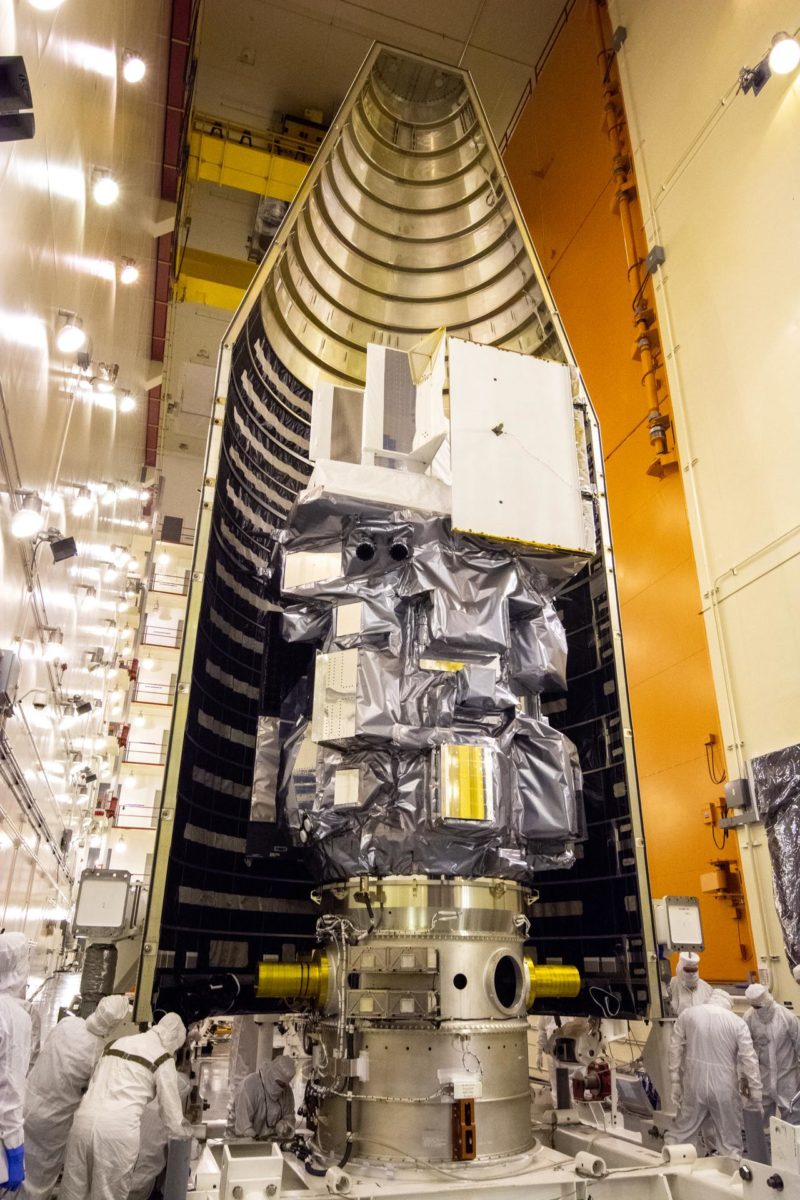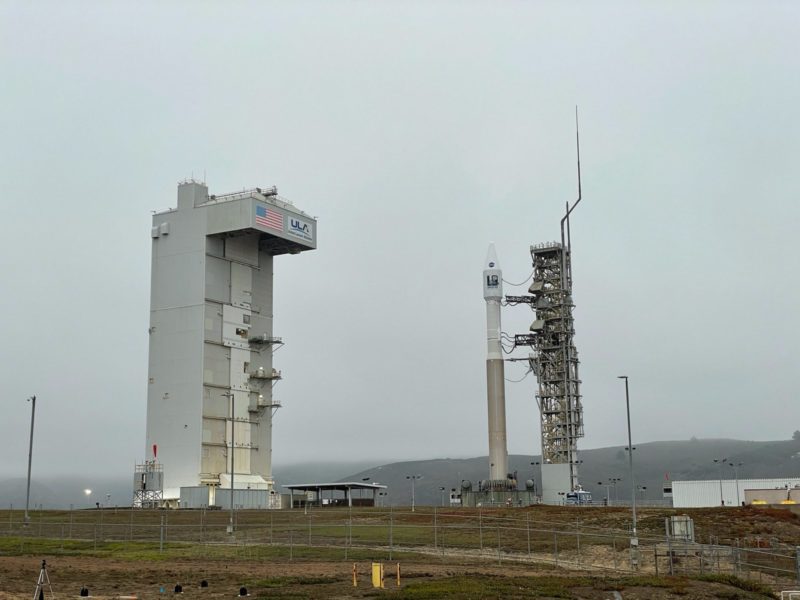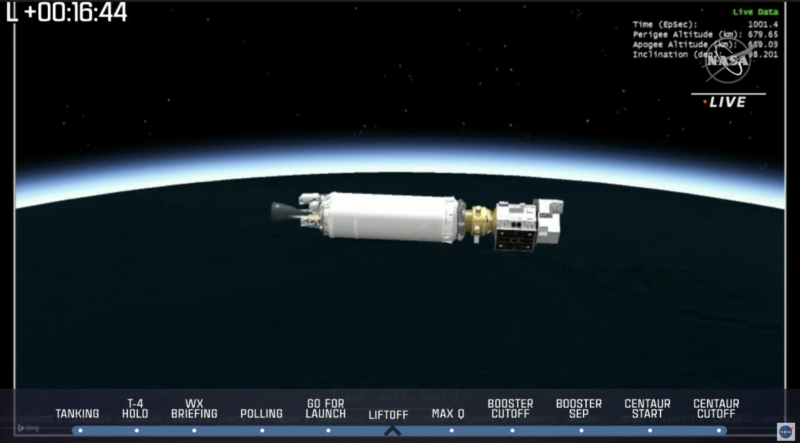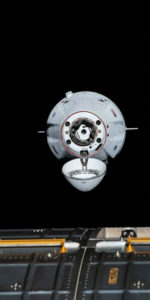
A roll of thunder broke the stillness of a foggy West Coast Monday afternoon, as United Launch Alliance (ULA)’s mighty Atlas V roared aloft from Space Launch Complex (SLC)-3E at Vandenberg Space Force Base, Calif., laden with the Northrop Grumman Corp.-built Landsat-9 payload on behalf of NASA and the U.S. Geological Survey (USGS).
Liftoff occurred on time at 11:12 a.m. PDT and Landsat-9—the latest in a series of Earth-monitoring and geological surveying spacecraft, whose heritage dates back almost five decades—is headed for insertion into near-polar, Sun-synchronous orbit. For the first time, the Centaur was set to execute four “burns” of its powerful RL10C-1 engine to lift Landsat and four CubeSat rideshare payloads to their desired orbital slots, before deorbiting itself safely at the end of its mission.
As outlined in AmericaSpace’s preview story, today’s flight marks the first ULA launch in more than four months, following a frustrating summer which has seen the Space Test Program (STP)-3 mission and the second Orbital Flight Test (OFT-2) of Boeing’s troubled CST-100 Starliner to the International Space Station (ISS) extensively delayed.
STP-3 was originally set to fly in February, but was postponed until June in response to payload-readiness issues, before being grounded again in the wake of anomalous Centaur engine behavior during an Atlas V launch in May. Meanwhile, the long-awaited OFT-2 mission found itself delayed from March until July, before it was stood down indefinitely in early August following a propulsion valve issue.

In marked contrast to these woes, the Landsat-9 campaign has proceeded with relative smoothness, both the payload and its launch vehicle—the Atlas V Common Core Booster (CCB) and Centaur upper stage—having arrived at Vandenberg in July.
“Landsat data constitutes the longest continuous record of Earth’s surface as seen from space,” said Steve Krein, vice president of civil and commercial satellites at Northrop Grumman Corp. As a trusted NASA partner, this spacecraft builds upon Northrop Grumman’s long history of delivering Earth observing spacecraft and continues the legacy of Landsat for years to come.”
Last month, Landsat-9 was encapsulated inside its Extra-Extended Payload Fairing (XEPF) and on 3 September the rocket was put through a fully-fueled Wet Dress Rehearsal (WDR) to iron out any issues ahead of launch. Two weeks ago, the payload was attached atop the vehicle, raising the total height of the “stack” to 194 feet (59.1 meters).

A Launch Readiness Review (LRR) on Saturday established a T-0 at 11:12 a.m. PDT, with the “window” for Monday’s opening attempt extending 26 minutes to 11:38 a.m. PDT.
Today’s countdown began about 3 a.m. PDT, eight hours before the scheduled launch time, with clocks beginning to count from the T-7 hour point. This apparent discrepancy was due to the presence of two built-in “holds”, each lasting 30 minutes: one at T-2 hours, just prior to the onset of cryogenic fueling, and the second at T-4 minutes, before the Terminal Count.

The operation was conducted from the Remote Launch Control Center (RLCC), situated about 6.5 miles (10.4 km) from the pad. The rocket was promptly powered up, as teams worked to test the avionics and guidance systems, ahead of the rollback of the 260-foot-tall (79-meter) Mobile Service Tower (MST).
Weather conditions held steady at 90-percent favorable, with Launch Weather Officer Capt. Addison Nichols of the U.S. Space Force’s Space Launch Delta 30 weather squadron pointing to low stratus clouds at 700 feet (210 meters), unrestricted visibility, northwesterly winds of 10 gusting to 15 knots and temperatures hovering near 16 degrees Celsius (62 degrees Fahrenheit).
This favorable outlook allowed for a “Go to Roll” authorization from ULA Launch Conductor Scott Barney and ULA Launch Director Tom Heter III. Shortly after 5:30 a.m. PDT, high-pressure hydraulic cylinders began jacking the 11-million-pound (5-million-kg) MST to prepare for rollback.
Over a period of about a half-hour, the huge tower rolled away from the Atlas V to its “park” position, about 250 feet (76 meters) to the southeast. Now alone in the glare of floodlights, the Atlas V was put through further tests of its flight controls to demonstrate that its RD-180 main engine and the RL10C-1 engine of the Centaur could properly cycle fuel valves and execute steering commands as issued. Pad crews departed SLC-3E shortly after 8 a.m. PDT and retreated clear of the blast danger zone, ahead of the onset of fueling.

The Atlas V CCB is fueled by a highly refined form of storable rocket-grade kerosene (known as “RP-1”), some 25,000 gallons (113,650 liters) of which were pumped into the rocket on 20 August. The Atlas V CCB oxidizer consists of 48,800 gallons (221,850 liters) of liquid oxygen, with an additional 4,150 gallons (18,865 liters) of liquid oxygen and 12,300 gallons (55,900 liters) of liquid hydrogen destined for the Centaur’s tanks.
Tanking of this massive cryogenic load—totaling over 65,000 gallons (295,500 liters)—got underway shortly after 8:40 a.m. PDT, some 2.5 hours ahead of liftoff.

The process moved swiftly, although about an hour into the fueling process teams were obliged to troubleshoot an issue pertaining to the liquid oxygen flow-rate into the Atlas V CCB. “Tanking is underway”, tweeted ULA CEO Tory Bruno shortly before 10 a.m. PDT. “Had a sticky LOX valve, but now resolved. Mighty Atlas is carbo loading.”
As the countdown headed inside an hour before launch, cryogenic loading concluded and entering “topping”, a period of necessary replenishment as the super-chilled propellants naturally boiled away.

Meanwhile, the weather remained optimum, although earlier forecasts for “unrestricted visibility” came to nought, as the notorious Vandenberg fog rolled in. However, it proved not to be a constraint to launch. At 10:38 p.m. PDT, the count entered the final built-in hold at T-4 minutes, emerging on time at 11:08 p.m. PDT.
The Atlas V’s Russian-built RD-180 engine roared to life at T-2.7 seconds, quickly ramping up to 860,200 pounds (390,000 kg) at the instant of liftoff. Today’s mission used the 401 “workhorse” of the Atlas V, numerically designated to identify its 13-foot-diameter (4-meter) payload fairing (“4”), no solid-fueled strap-on boosters (“0”) and the presence of a single-engine (“1”) Centaur upper stage.

The stack headed smoothly uphill and disappeared into the low-level Vandenberg murk, passing Mach 1 and experiencing peak aerodynamic stress on its airframe just over a minute into flight. The RD-180 shut down as expected four minutes after launch and the CCB was discarded, leaving the Centaur alone to complete one of the most exacting tasks of its career.
Previous Centaurs completed up to three discrete “burns” to insert their payloads into orbit and “deorbit” themselves safely at the end of their missions. But in addition to Landsat-9, today’s flight includes four small CubeSat rideshare passengers, sponsored by NASA, the Defense Innovation Unit (DIU), the Air Force Research Laboratory (AFRL) and the Missile Defense Agency (MDA).

Those tiny satellites are mounted on the Space Force’s Evolved Expendable Launch Vehicle Secondary Payload Adapter (ESPA) Flight System (EFS).
The first Centaur burn, lasting 12 minutes, served to deliver Landsat-9 into its precise orbital location, with an expected perigee of 414.2 miles (666.6 km) and an apogee of 422 miles (679.2 km), inclined 98.22 degrees to the equator. The spacecraft separated from the Centaur a little over an hour later at 12:32 p.m. PDT.

With Landsat-9 gone and en-route to its ambitious voyage, the upper stage’s task was not over. Beginning 30 minutes after the departure of Landsat-9, a pair of Centaur burns—running for ten seconds each, with a 20-minute gap between each burn—were executed in support of the deployment of the four CubeSats. A final burn of about 25 seconds ensured that the Centaur re-enters safely at the end of its mission.
FOLLOW AmericaSpace on Facebook and Twitter!
Missions » Landsat »





5 Comments
5 Pings & Trackbacks
Pingback:Mighty Atlas Launches Landsat-9, Rideshares to Orbit on First Four-Burn Centaur Mission
Pingback:Climate Appears Favorable for Earlier than-Daybreak Saturday Launch of Lucy Mission « AmericaSpace - Technology News
Pingback:Weather Looks Favorable for Before-Dawn Saturday Launch of Lucy Mission « AmericaSpace
Pingback:Lucy Launches, Begins Multi-Billion-Mile Trek to Explore Dawn of the Solar System
Pingback:Weather Looks Favorable for Before-Dawn Saturday Launch of Lucy Mission